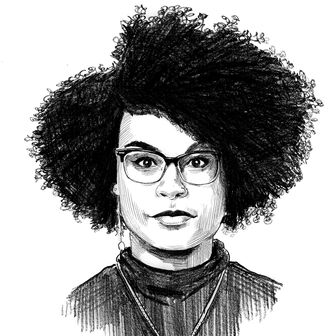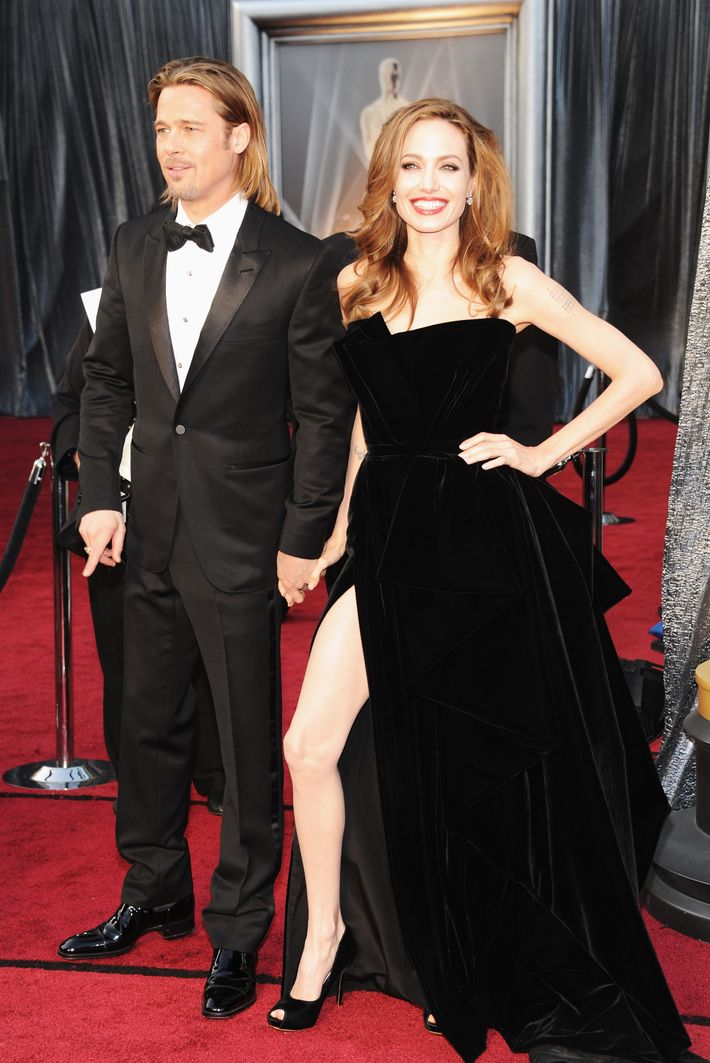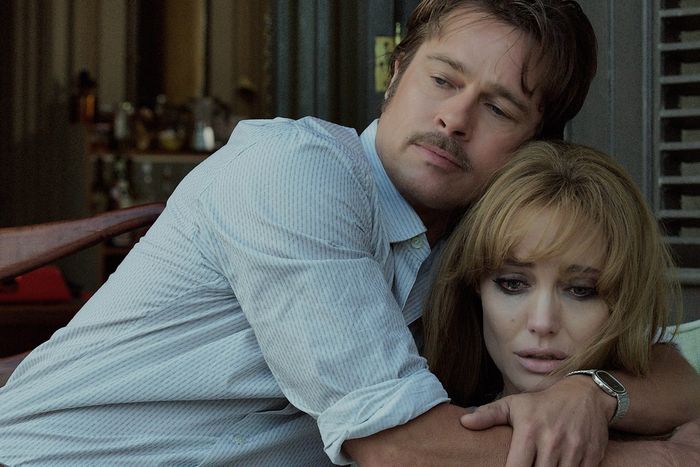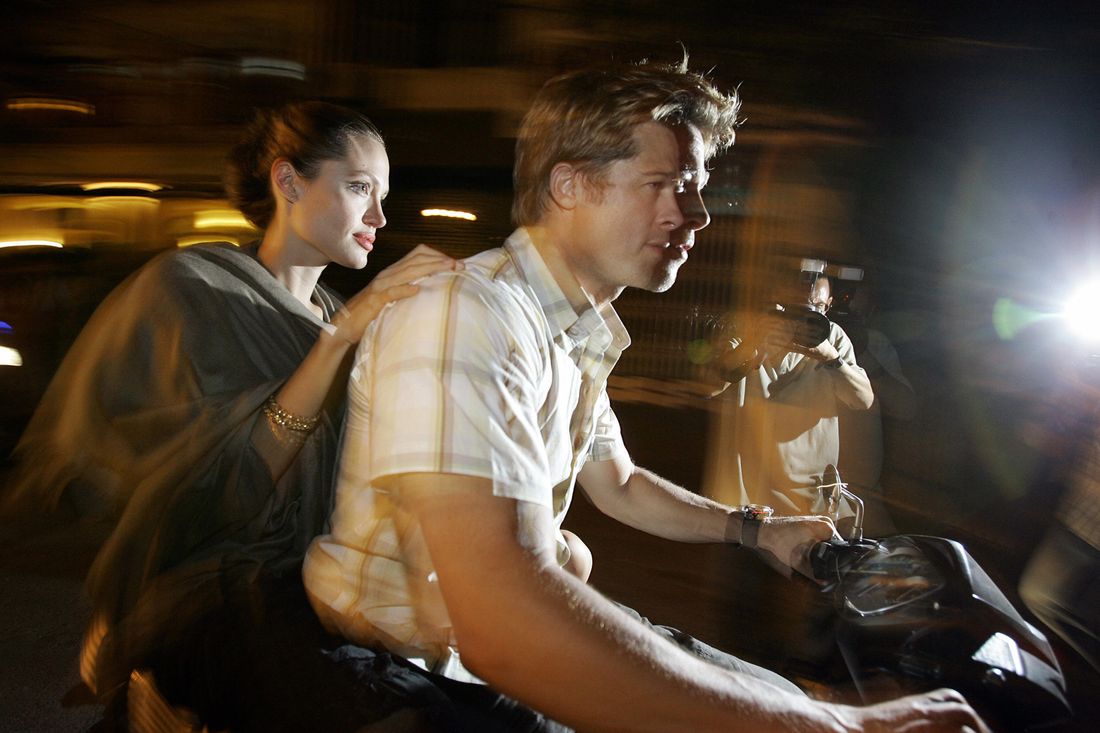
At the June 2005 premiere of Mr. & Mrs. Smith, it didn’t matter that Brad Pitt was casually rocking a shock of peroxide-blond hair, distressed jeans, and a deep-brown leather jacket, all working hard to distract from his ecstasy of a smile. He was a vision, and so was Angelina Jolie. When she charged from the back of a limo in a black gown (also leather), tits hiked to the heavens, chestnut-brown hair slicked back off her face, it’s no wonder the crowd swelled in volume. Pitt and Jolie never actually got that close to each other at the event; in most of the pictures taken of them, others fill the frame. But one photographer did manage to capture them together. Physically they remain apart, his body facing the opposite direction and awkwardly blocking half the shot. But her eyes, beaming his way, tell a story of closeness. Here are two heavenly bodies, each outshining everyone in their path, poised to become the greatest couple of the modern age.
This was a different time in the history of stardom. Social media wasn’t a compulsory platform upon which famous people could play out their lives as if they were at all relatable to ours. IP hadn’t yet become king, so studios still warred with one another over who could attract the most compelling names and faces rather than dusty franchise rights. Pitt and Jolie were actors, yes, and they were celebrities too, but they had each individually earned a label not every actor or celebrity can: movie star. It’s a distinction that refers to more than just sex appeal and charisma and points to a figure’s ability to, as film historian Jeanine Basinger puts it, make myth and ritual out of themselves.
A month before their show of prim civility at the premiere of their first movie together, Pitt and Jolie, clearly coupled up, would be featured on the cover of Us Weekly with Jolie’s young son Maddox on a Kenyan beach. The paparazzi photo added certainty to the rumors that their affair had begun on the set of Mr. & Mrs. Smith, torpedoing Pitt’s “golden couple” marriage to Jennifer Aniston. This was around the same time that the Sun ran a story that said “Brad Pitt and Angelina Jolie made so much noise during a hotel romp that other guests thought they had been attacked by wild animals.”
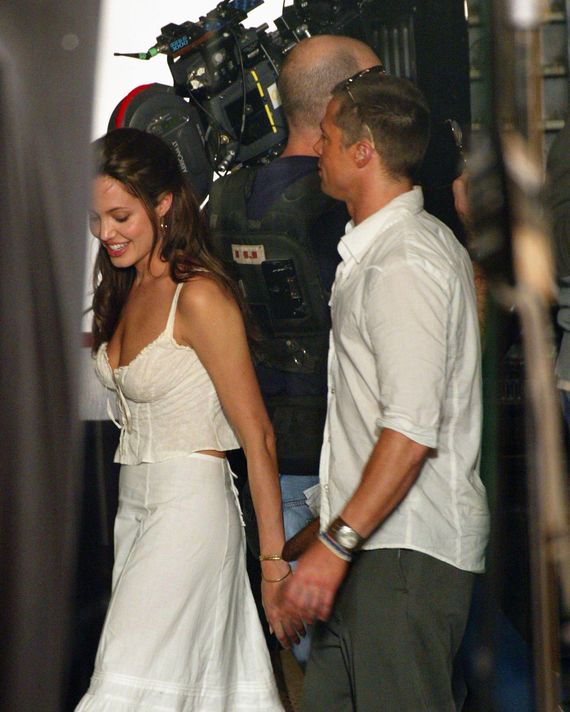
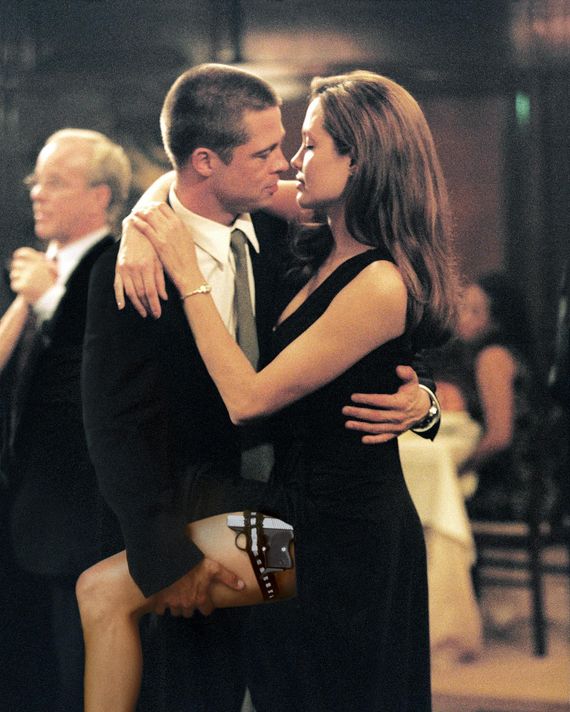
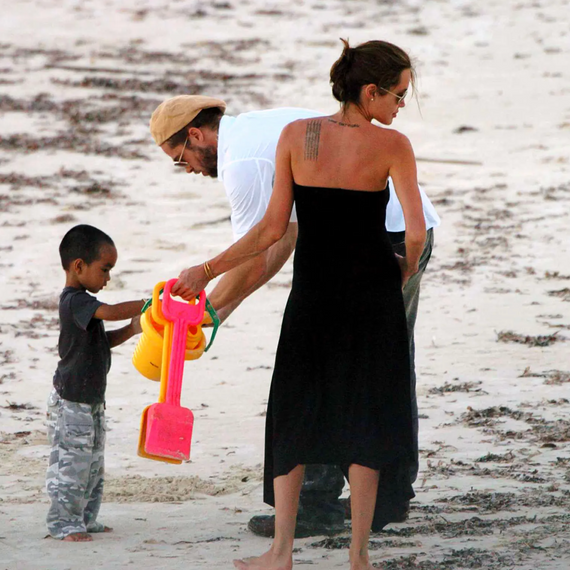
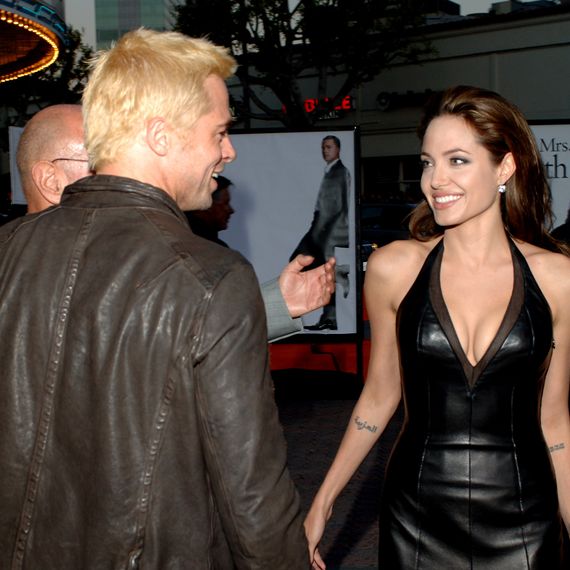
Whether people were fawning over their union, lambasting it, or cheekily sending it up with TEAM JOLIE shirts, as Paris Hilton once did, everyone was obsessed. They were two people seemingly at the peak of their beauty, influence, and power. And part of the appeal was in how diametrically opposed their reputations were. He was the Missouri-raised, laid-back pretty boy who made it out to Hollywood. She was the wild child, and her relationship to the industry was inherited. They seemed to inhabit such different worlds that parsing what exactly brought them together made them all the more intriguing. As a couple, Pitt and Jolie offered what all great stars do: a fantasy, as out of reach as it is alluring. In their decade-long union, they transformed from a lasciviously adulterous, sexed-up power couple to a more gently constructed, philanthropic team defined as much by their capacity for good as their astounding beauty and talent.
Until the fantasy cracked in 2016, when Jolie announced she was filing for divorce after a plane ride during which Pitt allegedly injured Jolie and their children while on a drunken rampage. Their separation has stretched on for years as they’ve fought over custody of their children; in recent months, their legal battles entered the public conversation, centered on their once-shared winery, with Jolie leveling more serious accusations of abuse at Pitt. The divorce proceedings aren’t just a story of assets divided — they will test their respective places in the popular imagination. Because Brangelina was always just that: an enchantment that was shored up in the media, and that Pitt has been far better at maintaining in the long run.
The image-making power of Brangelina was first exercised in the pages of a bombshell July 2005 issue of W magazine. Here was the start of a yearslong collaboration in media, spanning gossip rags and the refined pages of fashion magazines.
Slyly titled “Domestic Bliss,” the portfolio by photographer Steven Klein featured the couple in 1960s styling and chilly Douglas Sirk–esque color schemes. Pitt and Jolie play out a dream of wealth and sorrow in a glamorous white suburban setting. A gaggle of blond children dutifully bow their heads to say grace at the dinner table with Pitt and Jolie framed as their acutely fashionable parents. Tension simmers as she examines her immaculate manicure in a Luisa Beccaria silk dress; he broods over her shoulder in a Thom Browne suit. She’s unconsciously supine, made to appear in a pill-addled haze, wearing a magenta Narciso Rodriguez wool and silk crêpe dress as he, in a suit sans jacket — as if he just got home and is not quite eager to clean her mess — kneels to scoop her up. Page after page of it. A gourmand’s dark thrill.
The W shoot, which Pitt reportedly had a hand in conceptualizing, is a study in harnessing the power of transgression. Pitt goes darker, while Jolie plays into a refined side of her sultry image. It felt bracing considering the images they had fashioned before.
Before he met Jolie, Pitt was known for his casual cool onscreen; he was not just a heartthrob but the heartthrob in films as varied as his breakout, Thelma & Louise, and ’90s melodramas like Legends of the Fall. His relationship with sitcom sweetheart Aniston, whose California lifestyle and sun-kissed gorgeousness was and remains key to her beloved, approachable image, coincided with an increased lightness in his work in the late ’90s and early aughts with Ocean’s Eleven and The Mexican. (Fight Club, with its homoerotic machismo and social commentary, was an outlier.)
If Pitt was an idol beaming sunshine wherever he went, Jolie was all edge, wild and sexy and tactile. The early imagery that comes to mind is from her life offscreen: a vial of blood dangling from her neck, those famous lips spread into a smile as she and second husband, Billy Bob Thornton — who ghosted fiancée Laura Dern to marry her — wax poetic on a red carpet about fucking in the back of the car on the way there. It’s her swimming in a pool in her gown at a Golden Globes after-party in 1999. It’s her nearly making out with her brother after winning an Oscar in 2000 before she was 25, decked in all black, a modern Morticia Addams. But Jolie also projected a depth that made her next moves both understandable and surprising. By the time she met Pitt, she was turning a corner, having taken on the responsibilities of a UNHCR ambassador in 2001 and adopting her first son, Maddox, in 2002. Jolie was a woman in the midst of an evolution.
The W shoot would cement another idea of her that was already starting to form. Shortly before it came out, Pitt gave an interview with Diane Sawyer in which she grilled him about their relationship: “Did Angelina break up your marriage?” Sawyer asks bluntly. Pitt responds with a swift “no” before Sawyer speaks to Jolie’s reputation: “Everyone says she’s a home-wrecker.” Pitt gets to the heart of the matter in his response: “It’s a good story.”
The supposed love triangle, which continued to grace the pages of trashy magazines up until the divorce, reflects an age-old dynamic that Hollywood and tabloids love to juice, dating back to when Elizabeth Taylor married Eddie Fisher, severing his marriage with Debbie Reynolds: the sexy, dangerous “other woman,” the heartbroken blonde sweetheart, and the man somehow caught in the middle. The way Pitt and Jolie’s union was written about allowed people to project larger ideas about womanhood, desire, and America’s puritanical obsession with adultery.
But the tense dynamic with Aniston is actually the least interesting aspect of Pitt and Jolie’s relationship. What’s most compelling is how they elevated each other in the public eye. In many ways, they each offered the other a different kind of legitimacy and power. For him, it was the legitimacy of high-minded activism, the idea that he was deeper than his screen image, who chomped on food with gusto and had a light, almost breezy touch. For her, it’s less straightforward: The relationship reaffirmed that Jolie’s stardom was born of a private life made public. Pitt was a magnet for the ravenous press, and she gained a level of visibility she hadn’t quite inhabited before. But it also bolstered her as an artist, a reciprocal dynamic that would persist throughout their relationship. He became a producer-kingmaker who worked with modern auteurs; she started her career as a director. Together, they vaulted into an artistic, charitable second chapter.
We’re constantly in competition with each other,” Jolie told Vogue during a January 2007 cover-story interview. “We push each other to be better. Even if it’s just a better bike rider or a better pilot.” The article is a profile of Jolie, but the most crucial picture is the one Annie Leibovitz took of the couple together on an airstrip off Route 40 with a crew of 50. Jolie is in a Rag & Bone trench coat and leather pants, hair billowing off her face, eyes trained to the sandy ground, while Pitt, perched on a motorcycle, stares eagerly at her from behind a pair of sunglasses. Here are two millionaires racing each other on bikes and piloting airplanes for the vertiginous pleasure of it. The allure of their partnership as it settled into its comfortable rhythms was that it was a symbiotic one — a rarity for heterosexual unions of this visibility.
By this time, they had three kids — Maddox, Zahara, and Shiloh (Pax would join the family two months later) — and were embarking on a new phase in their public lives. The cover story, in which Jolie opened up for the first time about her romance with Pitt, set the tone for their early years together. They were gallivanting adventurers (Jolie flew her own single-engine plane to the shoot and took both the feature writer and Leibovitz into the air). They were peripatetic, bouncing from India to Ethiopia back to Southern California. They put their growing family first. They were hyperaware of how the flashing cameras crowded their lives but eager to use that attention to spotlight the causes that mattered to them. The profile doesn’t foreground the specific work of their activism so much as the reasons that brought them to it — their family — as well as how it influenced their decisions as actors. Discussing her role in A Mighty Heart as the wife of slain journalist Daniel Pearl, Jolie talks about her real-life friendship with the woman she plays: “We have a lot of things in common. Mariane worked for many years in radio and journalism in different areas of migration. So obviously my working with refugees … we have just great discussions about a lot of women’s issues and issues to do with children that we both care a lot about.”
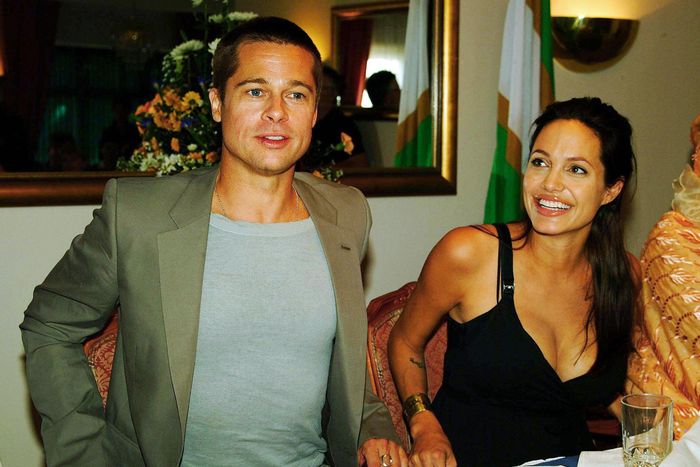
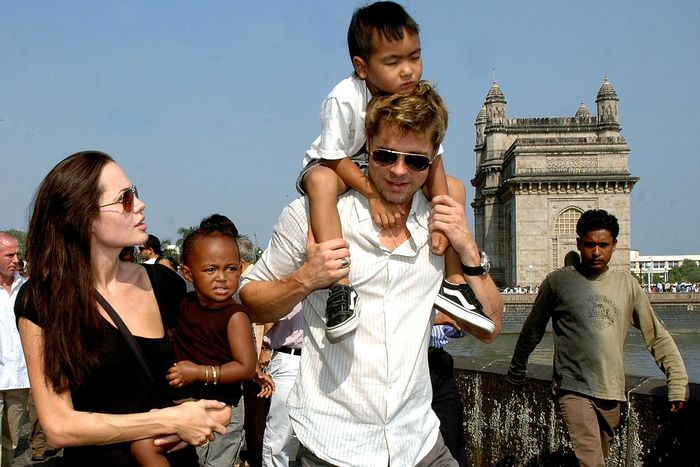
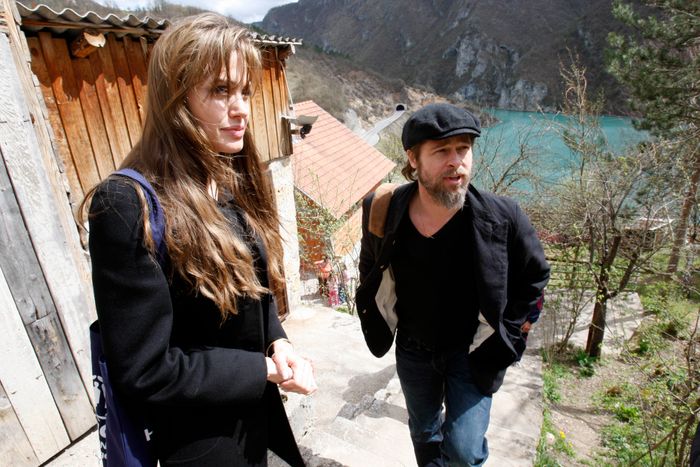
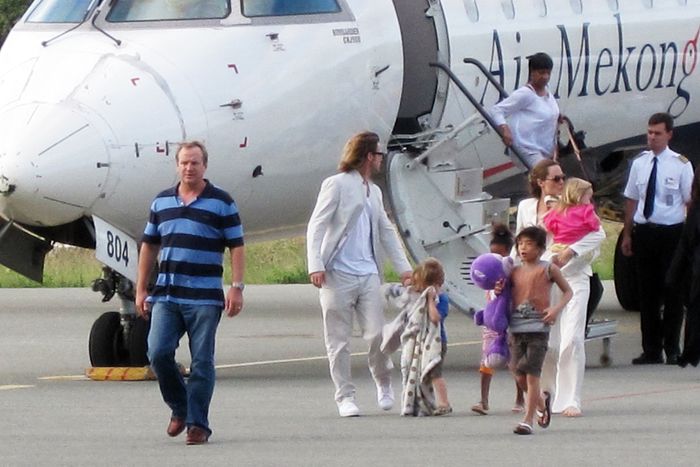
The public was well aware of how they leveraged their fame to support the causes dear to them; they reportedly earned $4 million for a People magazine cover of Shiloh in 2006, $2 million for a cover featuring Pax in 2007, and $14 million for a cover with the twins the following year. (Around the same time, Pitt would pledge $5 million in matching donations to his Make It Right campaign, which sought to build sustainable housing in areas of New Orleans devastated by Hurricane Katrina.) If Vogue and Vanity Fair appreciated the luxurious scope of their globe-trotting partnership, People was crucial to the coverage of their sacrificial philanthropy.
At the 2008 Independent Spirit Awards, Jolie was nominated for Best Female Lead for her performance in A Mighty Heart. The film did poorly at the box office, but it was warmly received by critics and awards bodies. Pitt produced the film under his Plan B shingle. (The production company was initially a joint Pitt-Aniston venture — she would reportedly retain only a minor stake after their divorce. Aniston had previously said she was excited about “nurturing” A Mighty Heart and that she was considering playing Mariane herself.) As Mariane, Jolie gives a gently forceful performance that demonstrates a perceptiveness and dramatic skill that she would only intermittently develop onscreen. In hindsight, it is easy to see what all the emotional grit and sharp acting overshadowed at the time. In order to inhabit Mariane, Jolie wears a curly wig and dark contacts and has a slightly tanner skin tone to reflect that she is a light-skinned Black woman, born to an Afro-Cuban mother and Dutch father. This blackface — let’s name it what it is — was only critiqued and reframed in later years: Was this a family of delightful altruism or white saviorism? It is possible to hold two truths — that Jolie is a loving mother and that the adoption of children of color by rich white people is at best complicated and at worst exploitative. But who could think about that? At the Indie Spirit Awards, wearing a simple black dress and gentle waves in her hair, Jolie revealed that she was pregnant. Pitt, in aviators and a tan suit, looked like he’d taken a page from Robert Redford’s book. They were two glittering supernovas in love. Jolie went on to nab a Best Actress nomination for A Mighty Heart from the NAACP itself.
The beginning of the end of Jolie and Pitt’s intertwined star personae became evident with a single pale leg jutting dramatically out of a black velvet Versace gown at the 2012 Academy Awards. They were at the Oscars that year in support of Pitt’s Best Actor nomination for his gently affecting performance in Moneyball. By that point, the couple had settled into a more domestic rhythm; they had the twins, and they would get engaged that year despite once stating they wouldn’t marry until everyone in the country could (they wed in 2014). Whatever sizzle bolstered their early relationship had been replaced by a more traditional vision of romance.
On the red carpet that day, Jolie positioned herself in photographs with an uncharacteristic lack of grace, her gown’s thigh-high slit calling attention to the way she stretched her leg out for dramatic effect. An endless ream of memes lambasting the actress for seeming forced in her sexiness followed, placing her leg on a variety of figures or doubling it on the other side to make her look like a couture crab. It was the first time she seemed like a punch line. The next year, Jolie wrote a New York Times op-ed about her decision to have a double mastectomy owing to a gene that increased her risk of breast cancer. It was nothing like the leg moment — she was congratulated by a handful of celebrities, and the article led to what doctors dubbed the “Angelina Jolie Effect,” a spike in the number of genetic testings for breast cancer. And yet both had a way of making her feel more human, more vulnerable, a cinematic god come down to earth.
At the same time, Pitt was flying high. He was building a career as a producer, transforming from a modestly well-regarded actor to a powerful arbiter of value in Hollywood. He’d been doing production work under Plan B, alongside producers Dede Gardner and co-president Jeremy Kleiner, since the early aughts. He would often produce works he was involved in as a star, including The Tree of Life, Moneyball, The Assassination of Jesse James by the Coward Robert Ford, Killing Them Softly, and World War Z. But it was Steve McQueen’s brutal 12 Years a Slave that would earn Pitt an Academy Award when it won for Best Picture in 2014. In the years after this win, Plan B began focusing on works by or about people of color, including Okja and Barry Jenkins’s tremendous Moonlight. This allowed Pitt to align himself with a coterie of highly talented Black and brown creatives and turned his work behind the scenes into a kind of extension of the activism he and Jolie had become known for. “I can help in other ways,” he would tell GQ. “I just do better building a house for someone in New Orleans or getting certain movies to the screen that might not get made otherwise.”
As Pitt deepened his skills and visibility as a producer, Jolie’s career was entering a fraught period. She directed her first feature, In the Land of Blood and Honey, about the Bosnian war. It was tepidly received at best. “There’s a somewhat awkward instructional, at times almost proselytizing aspect to the story that seems of a piece with her laudable humanitarian work,” the New York Times critic Manohla Dargis wrote. By the time of her third feature film as a director, 2015’s Antonioni-esque ode to decayed glamour By the Sea, Jolie was seen not as an artist refining her craft in a new venue but as the pinnacle of pretension. Set in the 1970s in the south of France, it follows a married couple as they vacation in the wake of a great, unexplained loss. Roland (Pitt) is a writer intent on pickling himself while his wife, Vanessa (Jolie), a former dancer, pops pills. They are sexually inert until they discover a peephole to the room next door, providing a view into the lives of newlyweds whose glinting warmth is the opposite of their shadowy complications.
“From anyone else, it would be mystifying as to how something so dull and inept got made by a major studio,” Rich Juzwiak argued in Gawker. “From an A-lister, it makes sense. Superstar entitlement — that which comes from within and without — is the only logical explanation for this horrendous movie.” Jolie was swiftly lambasted for considering her own relationship to beauty and motherhood as worthy of sustained artistic consideration. The movie was seen as marking the death knell for the “celebrity vanity project.” Only the Times review from Dargis seemed interested in exploring what Jolie was doing as a director and actress. That same year, The Big Short, the Adam McKay financial dramedy that Pitt co-starred in and produced under his Plan B banner, was released and would go on to rack up several Academy Award nominations.
If Mr. & Mrs. Smith was the light fare that set the tone for Brangelina, By the Sea demonstrated what it looked like when the fantasy was over. In hindsight, the subject matter of the film — Pitt’s character’s alcoholism, Jolie’s character’s infertility — seems like an echo of the lives they were actually living at the time. There is a piercing sequence in which Pitt and Jolie, decked in white, dance until she becomes possessed with a sense of abandon; her image splinters across a host of mirrors poised above the dance floor. Compared to the scintillating sexual heat they demonstrated on the dance floors in Mr. & Mrs. Smith, when their titular characters also danced in off-white attire, marking the beginning of their romance, this is a melancholy vision. It is the only time Pitt has been directed by a woman in his more than 30 years as a star.
On September 20, 2016, the world learned that Jolie had filed for divorce from Pitt because of “irreconcilable differences.” Here is what we knew then: The FBI reviewed an incident in which Pitt allegedly got verbally and physically abusive with one of his children on the couple’s plane (the agency did not file charges). In a follow-up People article, titled “Brad’s Side of the Story,” an unnamed source said Pitt did not hurt his children. By the end of 2016, they reached a temporary agreement in which she maintained physical custody. They would also undergo individual counseling, and Pitt would voluntarily take drug and alcohol tests. Pitt and Jolie have spent the time since then locked in a tense battle over the custody of their six children.
Here is what we know now: After the flight back in 2016, Jolie told FBI investigators that Pitt had grabbed her by the head, shaken her, yelled at her, and pushed her into the bathroom wall. He allegedly choked one of the kids and hit another in the face. At one point, Jolie said, he poured beer on her and the children. Per the redacted FBI report, covered in the Los Angeles Times, one of her children asked, “Are you okay, Mommy?” Pitt allegedly yelled, “No, Mommy’s not okay. She’s ruining this family.” Jolie said his behavior had made her feel “scared” and “like a hostage.”
These disturbing details came to light in a countersuit Jolie filed against Pitt, who, in February, sued Jolie for selling her shares of Château Miraval — the French winery the couple co-owned — to the Stoli Group, saying they had an informal agreement that she wouldn’t. Jolie says they never had such an agreement and that she sold her stake only because their talks broke down over a nondisclosure agreement Pitt had asked her to sign that would have contractually prohibited her from speaking outside of court about his alleged physical and emotional abuse of their children. Pitt now wants a jury trial for the Miraval lawsuit, which would place more details of their divorce in the court of public opinion. Jolie has filed a separate lawsuit to understand why the FBI decided not to press charges against Pitt for the plane incident back in 2016. Meanwhile, Pitt’s “allies” told The Daily Mail Jolie had required a similar NDA and was mounting a “disinformation” campaign against him.
When a celebrity breakup plays out this publicly, the media becomes another weapon in the arsenal. In the immediate aftermath of their split, Pitt and Jolie headed to the glossy pages of the magazines that once adored them. Pitt’s moment came first, in a May 2017 issue of GQ. The piece is framed as a “raw conversation” with a heartbroken star who is redefining his life in the wake of a monumental loss. It isn’t wholly what he said that made an imprint on the culture so much as a single image from the shoot by photographer Ryan McGinley. (Pitt collaborated with the magazine and photographer on scouting potential destinations for the shoot, which took place in a variety of national parks.)
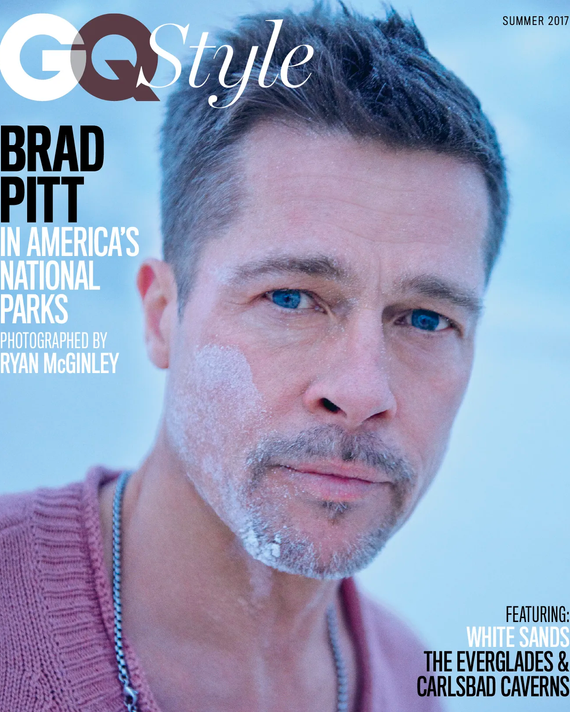
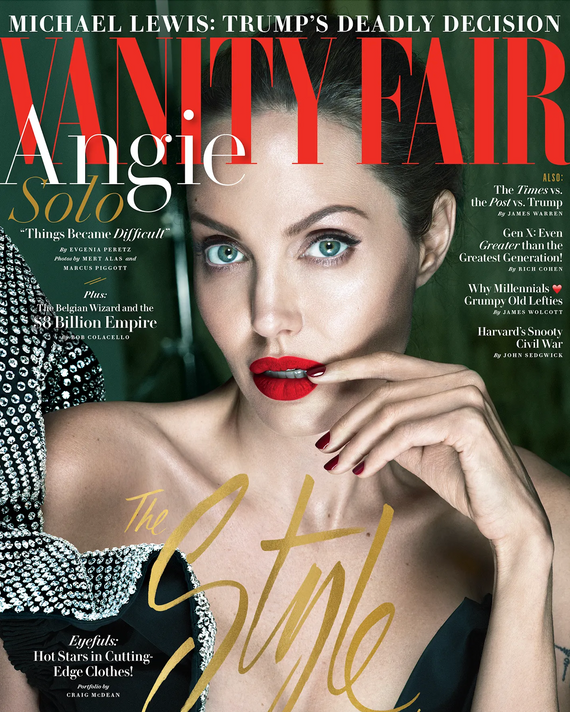
In a close-up set against the pale azure sky of the Carlsbad Caverns National Park, Pitt is rendered unguarded. Decked in a rust-colored Bottega Veneta suit jacket and sweater with a slim silver chain tucked underneath, he stands chin up, his lips parted as if about to speak. But it’s his eyes that do the true work — brimming with tears about to fall. This, the photograph suggests, is a man come undone. He would go on to work with GQ in 2019 for his Once Upon a Time in Hollywood … press tour and again in 2022 for a profile written by novelist Ottessa Moshfegh.
A few themes recur in all three. His relationship to his children, represented in the 2017 piece by the bikes and other childlike detritus that dot his solemn Craftsman home in the Hollywood Hills. His decision to quit alcohol and weed. “For me this period has been about looking at my weaknesses and failures and owning my side of the street,” Pitt says. And finally, his love of art and building things with his hands. In the age of the relatable star, Pitt made an intelligent shift toward such expectations. Here is Hollywood’s most golden god brought closer to our atmosphere.
Jolie’s September 2017 Vanity Fair cover profile by Evgenia Peretz accomplished the opposite. In the photo shoot, she’s as gorgeous as ever. In one image, she sits on the Warner Bros. studio lot in a director’s chair. Decked in a crisp white shirt and riding boots as the studio bustles around her in the background, she stares directly at the camera as if daring it to a challenge. The profile depicts Jolie as a woman seeking to take control of her own life, from her decision to have a mastectomy to prioritizing the Cambodian people in adapting Loung Ung’s 2000 memoir of the Khmer Rouge genocide, First They Killed My Father. But what came to dominate the narrative wasn’t her dedication to her politics and artistry. It was a detail about how the film was cast.
“To cast the children in the film, Jolie looked at orphanages, circuses, and slum schools, specifically seeking children who had experienced hardship,” Peretz writes. “In order to find their lead, to play young Loung Ung, the casting directors set up a game, rather disturbing in its realism: they put money on the table and asked the child to think of something she needed the money for, and then to snatch it away. The director would pretend to catch the child, and the child would have to come up with a lie.” After readers and reporters expressed concern over the casting practice, Jolie contacted Vanity Fair, arguing that Peretz had framed it incorrectly and hoping the magazine would retract the material and run a correction. Vanity Fair stood by the profile after reviewing the audiotapes from the interview, casting doubt on Jolie’s philanthropic efforts. Pitt struggles with his own credibility in that area, though it hasn’t stuck as much to him as it has to her. He just settled a class-action lawsuit for $20.5 million brought by the inhabitants of the Make It Right campaign’s shoddy housing, which was prone to leaks, rot, and other major structural problems, after years of criticism from Black residents in New Orleans’s Lower Ninth Ward for the way his organization has materially wrecked their lives.
In the years since the profile and the antecedent divorce, Jolie has continued to struggle to find her audience. Her 2021 films — the muscular action-drama Those Who Wish Me Dead and the tepid Marvel epic Eternals — failed to capture the imagination of viewers or critics. In many ways, she is coasting on residual star power, seemingly ambivalent about acting and more interested in directorial efforts. She has been far more guarded about her life in recent years, complicating audiences’ ability to project and connect. The most resonant image she’s committed to screen of late is bound up in her single motherhood: her line dancing on TikTok while dropping her daughter Zahara off at Spelman for the new school year.
Pitt hasn’t been seen publicly with his children since the divorce. Meanwhile, his power as a producer and actor has only become further enshrined. He won his first acting Oscar for Once Upon a Time in Hollywood … in 2020. This year, he stars in Damien Chazelle’s Jazz Age drama, Babylon, as a megastar inspired by the likes of John Gilbert and Clark Gable, and he’s a producer on three films: Women Talking, the Sarah Polley–helmed adaptation about women reckoning with the aftermath of assaults; Blonde, Andrew Dominik’s divisive, fictional take on the life of mid-century icon Marilyn Monroe; and She Said, the ripped-from-the-headlines newsroom drama detailing how two New York Times reporters wrote the story that took down Harvey Weinstein. (Pitt himself has worked with Weinstein on two films; Jolie, who had been assaulted by the producer, said in a 2021 Guardian profile, “I never associated or worked with him again. It was hard for me when Brad did.”) In recent months, Pitt has upped his press game. He’s been on the cover of Billboard illuminating his love of art by reestablishing a recording studio at Miraval and in the Financial Times flanked by friends, Los Angeles–based artist Thomas Houseago and musician Nick Cave, talking about using art to heal. He’s lent his image to a variety of pursuits that reflect a more tender masculinity, including a new skin-care line (which uses ingredients from the Miraval vineyard). In June, he played the role of the chummy ex you can still be friends with in a Goop interview by his onetime fiancée Gwyneth Paltrow to market his new cashmere-clothing business. In it, he spoke with soft reverence for Paltrow’s late father.
For Pitt, the abuse allegations, despite their severity and growing conversations about them online, have yet to make a dent. Meanwhile, people are already questioning Jolie’s motives, as NBC News discovered after reviewing hundreds of online comments about the case on YouTube, TikTok, and Twitter expressing skepticism about her accusations. Perhaps this is what happens when a star known primarily for her private life actually becomes private: Other people set the narrative for you.
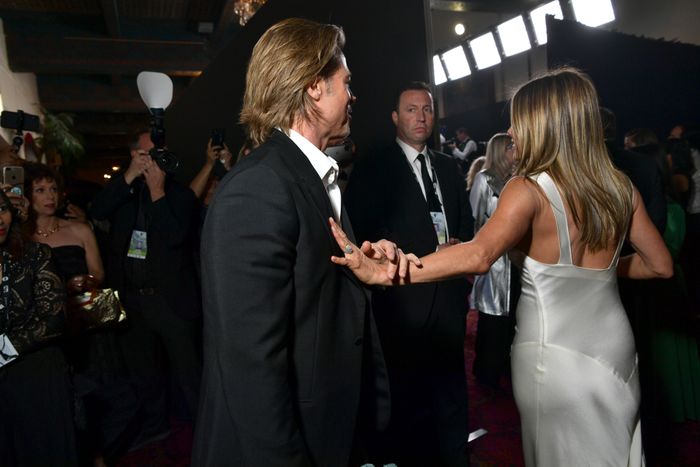
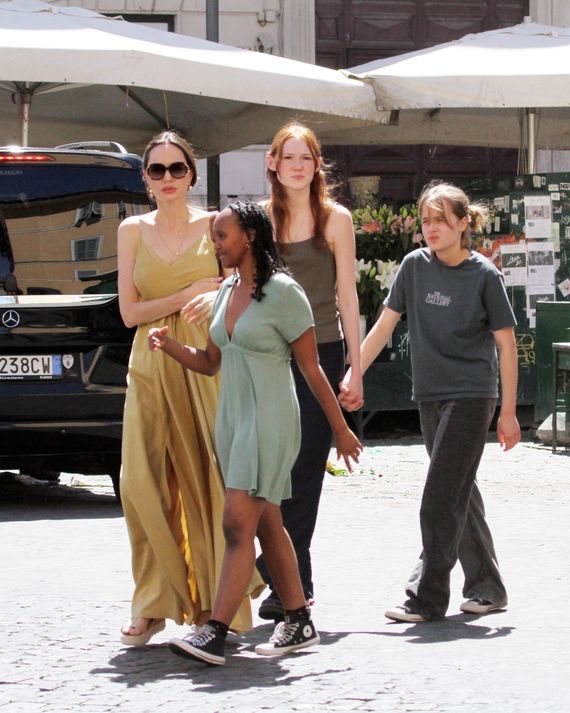
It’s hard not to notice how the current moment is replaying early images we associate with Brangelina — Jolie as the bad influence, Pitt as the innocent charmer caught in the drama. During his awards campaign for Once Upon a Time in Hollywood … , Pitt tapped into one of the most intoxicating powers in Hollywood’s arsenal: nostalgia. Throughout, he was gregarious, light on his feet, and as charismatic as ever, giving speeches so smooth people wondered if he had writers. Then, at the 2020 Screen Actors Guild Awards, he reconnected with Aniston, surrounded by the cameras and flashing bulbs of a hungry public. The exes beamed with approval when they won their respective awards. Photographers captured a reunion Vogue would deem “tender”; backstage, they smiled giddily at each other as he held his statuette, both of them in profile. But it’s another image of them that truly cinches the success of his campaign, not only for his Oscar win but for the public’s heart: Pitt in stark profile, Aniston with her back to the camera, walking away from him but with her hand still on his chest. He’s holding her there. It’s a fantasy of the man who did the work.
More on brangelina
- Vulture’s 20 Most-Read Stories in 2022
- Brad Pitt Accuses Angelina Jolie of Shadily Selling Their Wine Business
- Angelina Jolie Says Brad Pitt Hasn’t Paid ‘Meaningful’ Child Support


